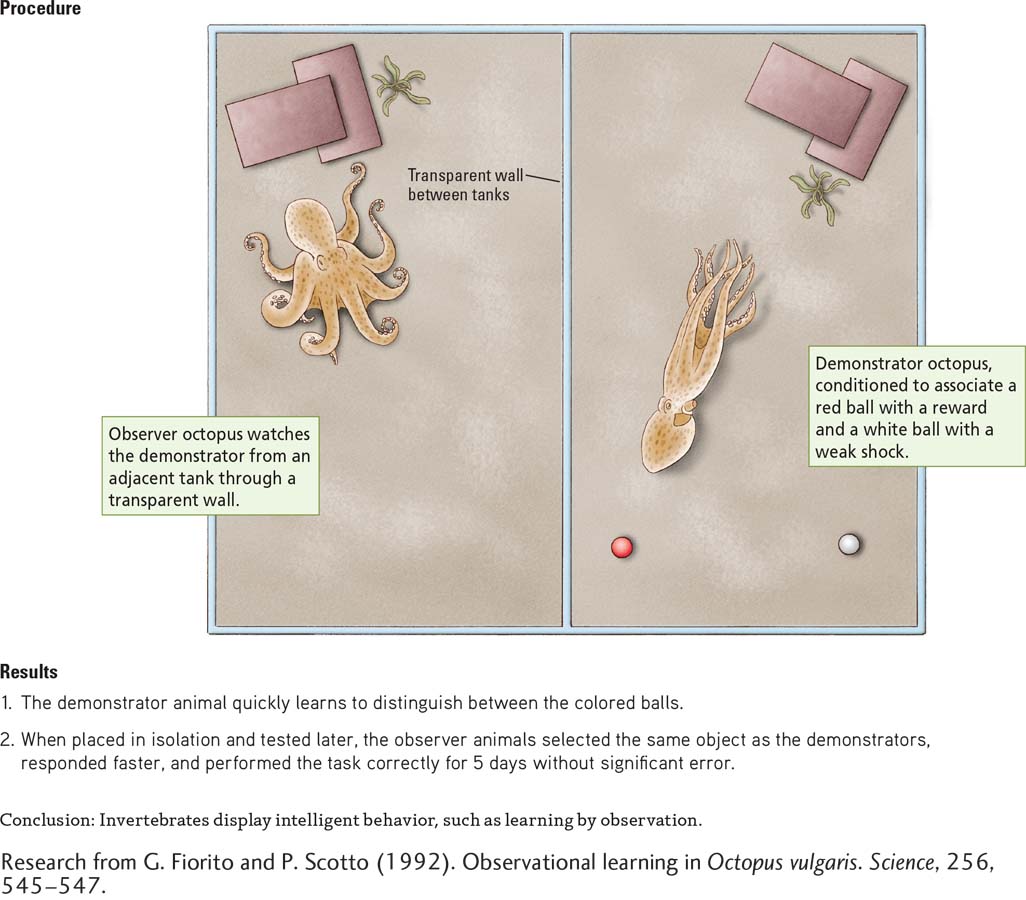2-2 The Nervous System’s Evolutionary Development
The developing brain, which is less complex than the mature adult brain, provides a clear picture of its basic structural plan. The striking biological similarity of embryos as diverse as amphibians and mammals is evident in the earliest stages of development. In the evolution of complex nervous systems in vertebrate species, simpler and evolutionarily more primitive forms have not been discarded and replaced but rather added to. As a result, all anatomical and functional features of simpler nervous systems are present in and form the base for the most complex nervous systems, including ours.
Section 1-3 outlines nervous system evolution and Section 8-1, developmental similarities among humans and other species.
48
The bilaterally symmetrical nervous system of simple worms, for example, is common to complex nervous systems. Indeed, we can recognize in humans the spinal cord that constitutes most of the simplest fishes’ nervous system. The same is true of the brainstem of more complex fishes, amphibians, and reptiles. The neocortex, although particularly complex in humans, is clearly the same organ found in other mammals.
Stages in Brain Evolution
In a vertebrate embryo, the nervous system begins as a sheet of cells. This sheet folds into a hollow tube and develops into three regions, forebrain, midbrain, and hindbrain, recognizable as a series of three enlargements at the end of the embryonic spinal cord (Figure 2-14A). The adult brain of a fish, amphibian, or reptile is roughly equivalent to this three-

In mammals (Figure 2-14B), the prosencephalon develops further to form the subcortical structures known collectively as the diencephalon (between brain) and the cerebral hemispheres and cortex, or telencephalon (endbrain). The mammalian hindbrain develops further into the metencephalon (across brain), which includes the cerebellum, and the myelencephalon (spinal brain), including the spinal cord.
The human brain is particularly complex, possessing especially large cerebral hemispheres but retaining most other mammalian brain features (Figure 2-14C). Various human cerebral areas—
The Nervous System and Intelligent Behavior
Principle 6: Brain systems are organized hierarchically and in parallel.
Most behaviors are the product not of a single locus in the brain but rather of many interacting brain areas and levels. These several nervous system layers do not simply replicate function; rather, each region adds a different dimension to the behavior. This hierarchical organization affects virtually every human behavior. Abnormalities associated with brain injury and brain disease that seem bizarre in isolation are but the normal manifestation of parts of a hierarchically organized brain. Our evolutionary history, our developmental history, and our own personal history are integrated at the various anatomical and functional levels of the nervous system.
49
Is the vertebrate nervous system the only path to evolving intelligent behavior? Invertebrate animals, such as the octopus, have traveled on an evolutionary pathway separate from that of vertebrates for over 700 million years. The octopus nervous system, while strikingly different from ours, is complex. Might the octopus learn much as vertebrate animals do?
Italian biologists Graziano Fiorito and Pietro Scotto (1992) placed individuals of Octopus vulgaris (the common octopus) in separate tanks, each with an independent water supply, and allowed them to interact visually for 2 hours. As shown in the Procedure section of Experiment 2-1, the observer octopus watched the demonstrator octopus from an adjacent tank through a transparent wall. The demonstrator was being conditioned to learn that a red ball was associated with a reward, whereas a white ball was associated with a weak electric shock.
As noted in the Results section, the demonstrator animals quickly learned to distinguish between the colored balls. The observers then were placed in isolation. When tested later, they selected the same object the demonstrators had, responded faster than the demonstrators did during their conditioning, and performed the task correctly for 5 days without significant error or further conditioning.
EXPERIMENT 2-1
Question: Does intelligent behavior require a vertebrate nervous system organization?
Procedure

50
2-2 REVIEW
The Nervous System’s Evolutionary Development
Before you continue, check your understanding.
Question 1
The brains of vertebrate animals have evolved into three regions: __________, __________, and __________.
Question 2
The functional levels of the nervous system interact, each region contributing different aspects, or dimensions, to produce __________.
Question 3
In a brief paragraph, explain how the evolution of the forebrain in mammals reinforces the principle that the CNS functions on multiple levels.
Answers appear in the Self Test section of the book.